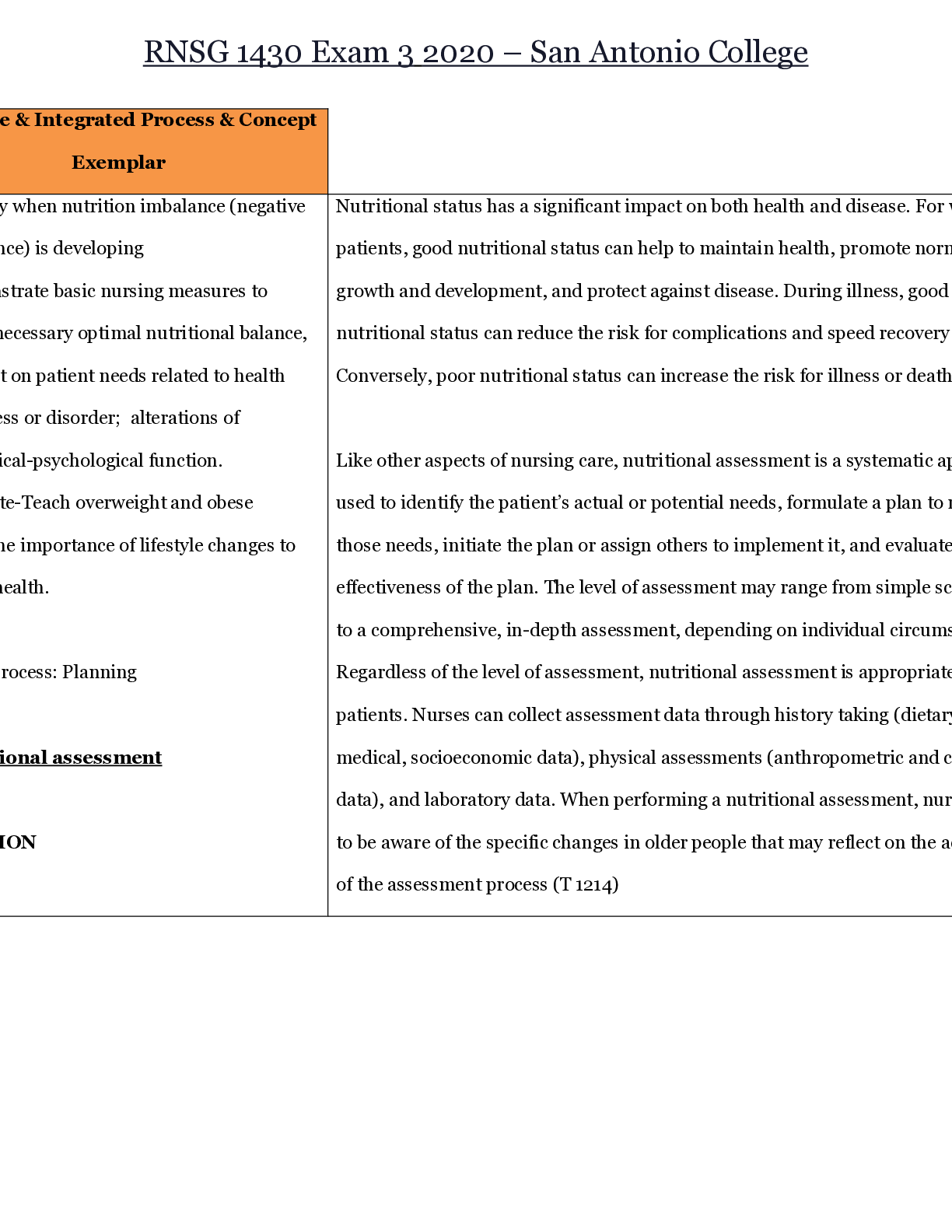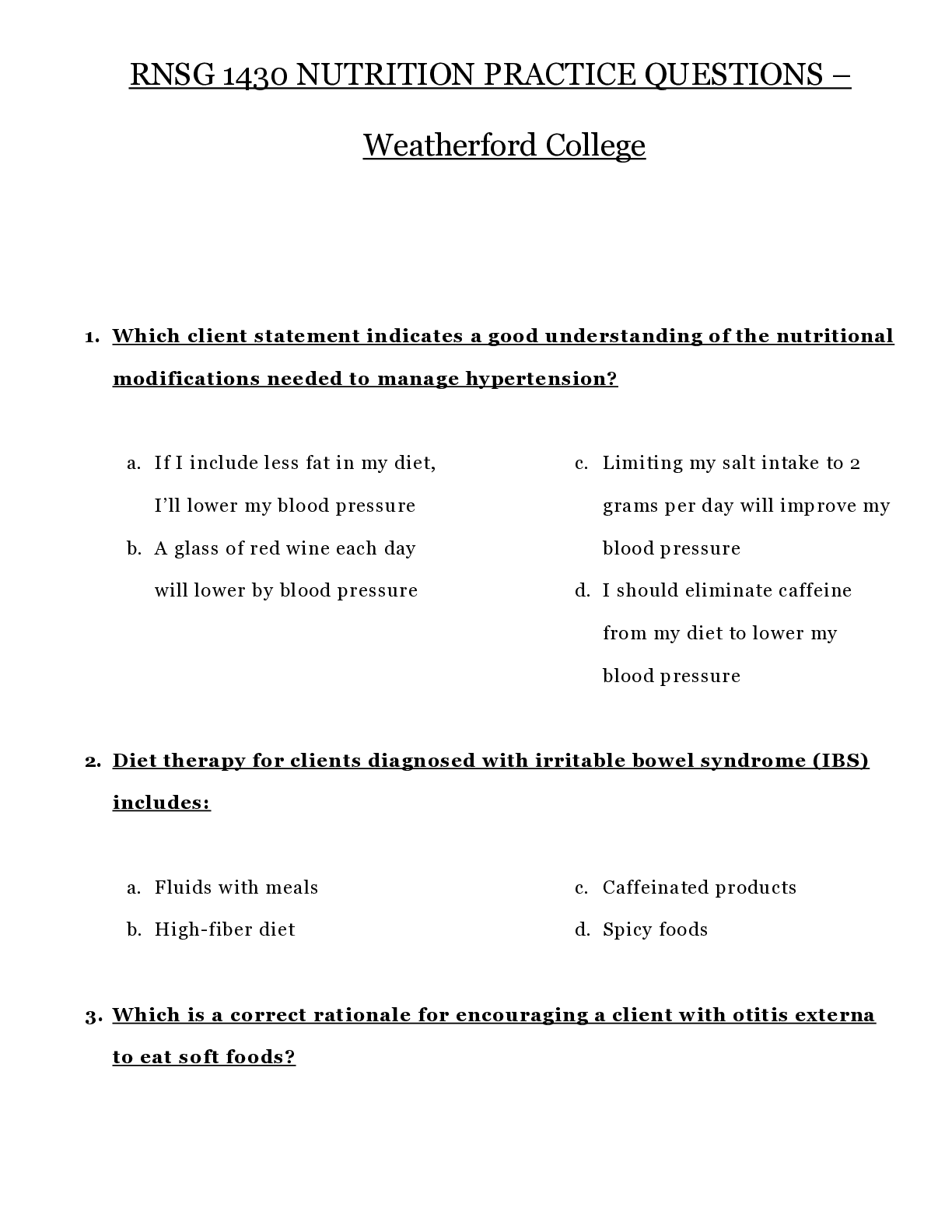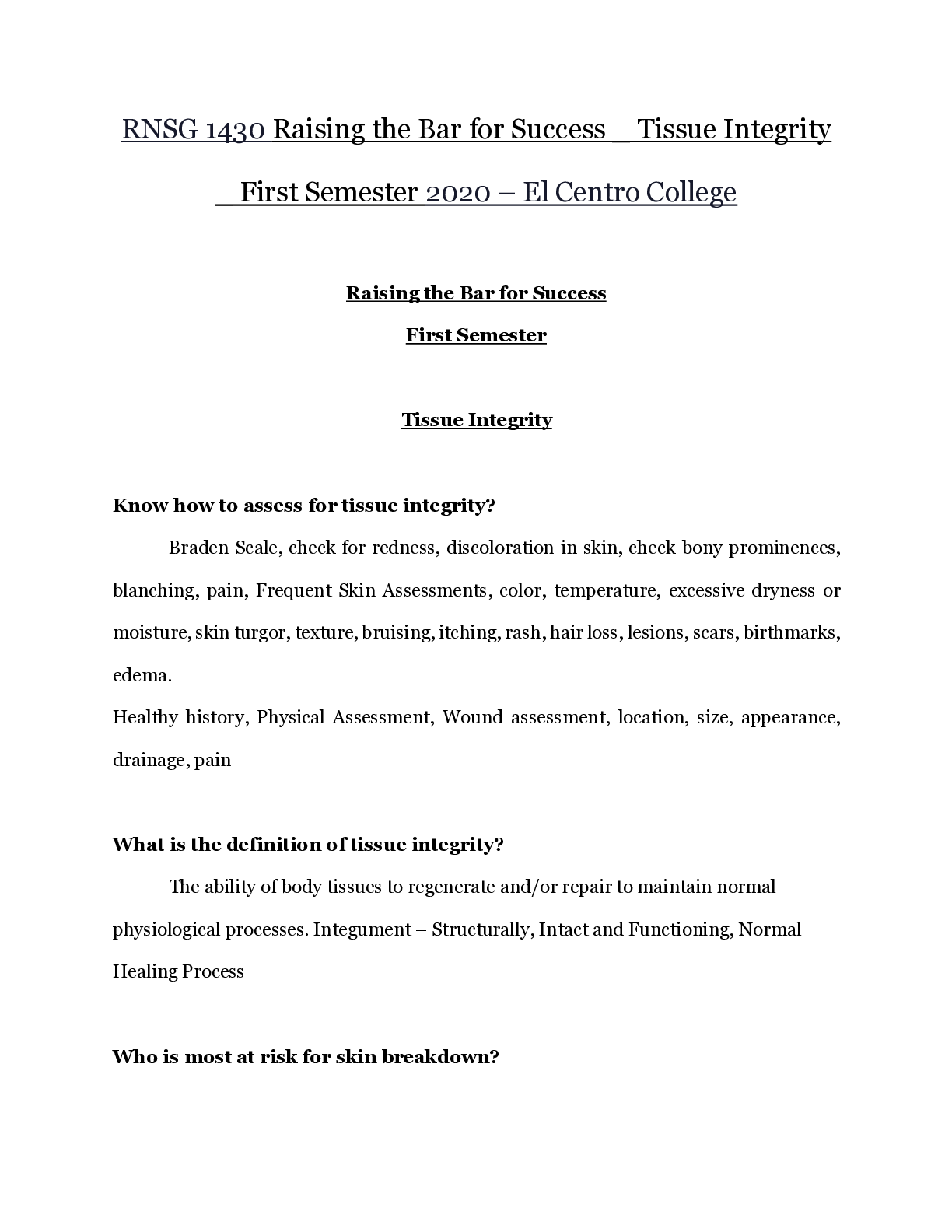*NURSING > EXAM > RNSG 1430 Health Care Concepts I Study Guide for Final Exam – San Antonio College | RNSG1430 Healt (All)
RNSG 1430 Health Care Concepts I Study Guide for Final Exam – San Antonio College | RNSG1430 Health Care Concepts I Study Guide for Final Exam
Document Content and Description Below
RNSG 1430 Health Care Concepts I Study Guide for Final Exam – San Antonio College 50 Question Final A. Sleep (4) Taylor chapter 33 1. Sleep deprivation - a decrease in the amount, consistency,... or quality of sleep. It may result from decreased REM sleep or NREM sleep. Total sleep deprivation is rarely seen, other than in experimental settings. There are many causes, and the manifestations progress from irritability and impaired mental abilities to a total disintegration of personality. In general, the effects of sleep deprivation become increasingly apparent after 30 hours of continuous wakefulness. The most recent classification of sleep disorders categorized by the International Classification of Sleep Disorders includes four major categories of disturbances: ● Dyssomnias ● Parasomnias ● Sleep disorders associated with medical or psychiatric disorders ● Other proposed disorders Dyssomnias include Insomnia - characterized by difficulty falling asleep, intermittent sleep, or early awakening from sleep. It is the most common of all sleep disorders. Hypersomnia is a condition characterized by excessive sleep, particularly during the day. This disorder is also referred to as idiopathic hypersomnia and is a debilitating condition. A person may fall asleep for intervals during work, while eating, or even during conversations Narcolepsy - a condition characterized by an uncontrollable desire to sleep. A person with narcolepsy can literally fall asleep standing up, while driving a car, in the middle of a conversation, or while swimming. Sleep apnea, generally referred to as sleep-disordered breathing (SDB), is a condition in which a person experiences the absence of breathing (apnea) or diminished breathing efforts (hypopnea) during sleep between snoring intervals. Restless leg syndrome (RLS) is a common sleep disorder that affects up to 15% of the population, most often middle-aged and older adults. People with restless leg syndrome (RLS) cannot lie still and report unpleasant creeping, crawling, or tingling sensations in the legs. B. Parasomnias - patterns of waking behavior that appear during REM or NREM stages of sleep. They are more commonly seen in children. Although parasomnias are commonly outgrown before adulthood, safety and prevention of injury are paramount concerns. i. Somnambulism or sleepwalking may range from sitting up in bed to walking around the room or the house to walking outside the house. The sleepwalker is unaware of his environment. ii. Bruxism - grinding of one’s teeth and frequently is an indicator of stress. iii. Enuresis - urinating during sleep or bedwetting. 2. REM/NON-REM a. NREM sleep (comprising about 75% of total sleep) consists of four stages. Stages I and II, consuming about 5% and 50% of a person’s sleep time, respectively, are light-sleep states. During these stages, the person can be aroused with relative ease. Stages III and IV, each representing about 10% of total sleep time, are deep-sleep states, termed delta sleep or slow-wave sleep. The arousal threshold (intensity of stimulus required to awaken) is usually greatest in stage IV NREM. Throughout the stages of NREM sleep, the parasympathetic nervous system dominates, and decreases in pulse, respiratory rate, blood pressure, metabolic rate, and body temperature are observed. b. It is more difficult to arouse a person during REM sleep than during NREM sleep. In normal adults, the REM state consumes 20% to 25% of a person’s nightly sleep time. People who are awakened during the REM state almost always report that they have been dreaming. They can usually vividly recall their dreams even if they were absurd or have no sensible meaning for them. Everyone dreams. During REM sleep, the pulse, respiratory rate, blood pressure, metabolic rate, and body temperature increase, whereas general skeletal muscle tone and deep tendon reflexes are depressed. REM sleep is believed to be essential to mental and emotional equilibrium and to play a role in learning, memory, and adaptation. 3. Interventions to promote sleep a. Follow a regular routine for bedtime and morning awakening. b. Accept individual differences in need for sleep. c. Use relaxation exercises to relax before bedtime, especially if feeling stressed. d. Avoid caffeine, smoking, and alcohol before bedtime. e. Adjust bed coverings, room temperature, and lighting to your preferences. f. Eat a small carbohydrate snack before going to bed. g. Be aware of the potential dangers of sleeping pills. h. Use some part of each day for quiet, enjoyable activities such as crafts, hobbies, and reading, watching television, listening to music, and visiting with friends. i. Incorporate three or four periods of regular exercise into each week. B. Comfort (4) Taylor chapter 34 4. Neurologic pain 5. Addiction/tolerance/dependence ● Addiction: a pattern of compulsive opioid use for means other than pain control. According to D’Arcy (2010a), the four characteristics that define addiction are a craving for the substance, compulsive use, lack of control over the drug, and continued use despite harm. ● Tolerance: occurs when the body becomes accustomed to the opioid and needs a larger dose each time for pain relief. The side effects diminish along with the pain relief. Tolerance does not indicate addiction. ● Dependence: a phenomenon in which the body physiologically becomes accustomed to long-term opioid therapy and suffers withdrawal symptoms if the opioid is suddenly removed or the dose is rapidly decreased. - - - - - - - - -- - - - - - - - - - - - - - - A. Elimination (5) Brunner chapter 48 32. Urinary Incontinence education, Pharmacologic Therapy Pharmacologic therapy works best when used as an adjunct to behavioral interventions. Anticholinergic agents inhibit bladder contraction and are considered first-line medications for urge incontinence. Several tricyclic antidepressant medications (e.g., amitriptyline [Endep], amoxapine [Asendin]) can also decrease bladder contractions as well as increase bladder neck resistance (Karch, 2012). Pseudoephedrine sulfate (Sudafed), which acts on alpha-adrenergic receptors, causing urinary retention, may be used to treat stress incontinence; it needs to be used with caution in men with prostatic hyperplasia and patients with hypertension. Hormone therapy (e.g., estrogen) taken orally, transdermally, or topically was once the treatment of choice for urinary incontinence in postmenopausal women because it restores the mucosal, vascular, and muscular integrity of the urethra. However, research suggests incontinence increases in women taking estrogen alone compared to placebo (Weinstein, 2012). Surgical Management Surgical correction may be indicated in patients who have not achieved continence using behavioral and pharmacologic therapy. Surgical options vary according to the underlying anatomy and the physiologic problem. Most procedures involve lifting and stabilizing the bladder or urethra to restore the normal urethrovesical angle or to lengthen the urethra. Women with stress incontinence may undergo an anterior vaginal repair, retropubic suspension, or needle suspension to reposition the urethra. Procedures to compress the urethra and increase resistance to urine flow include sling procedures and placement of periurethral bulking agents such as artificial collagen. Periurethral bulking is a semipermanent procedure in which small amounts of artificial collagen are placed within the walls of the urethra to enhance the closing pressure of the urethra. This procedure takes only 10 to 20 minutes and may be performed under local anesthesia or moderate sedation. A cystoscope is inserted into the urethra. An instrument is inserted through the cystoscope to deliver a small amount of collagen into the urethral wall at locations selected by the urologist. The patient is usually discharged home after voiding. There are no restrictions following the procedure, although occasionally more than one collagen bulking session may be necessary if the initial procedure did not halt stress incontinence. Collagen placement anywhere in the body is considered semipermanent because its durability averages between 12 and 24 months, until the body absorbs the material. Periurethral bulking with collagen offers an alternative to surgery, such as one for an older person who is frail (Keegan, Atiemo, Cody, et al., 2012). It is also an option for people who are seeking help with stress incontinence who prefer to avoid surgery and who do not have access to behavioral therapies. An artificial urinary sphincter can be used to close the urethra and promote continence. Two types of artificial sphincters are a periurethral cuff and a cuff inflation pump. Men with overflow and stress incontinence may undergo a transurethral resection to relieve symptoms of prostatic enlargement. An artificial sphincter can be used after prostatic surgery for sphincter incompetence (Fig. 55-2). After surgery, periurethral bulking agents can be injected into the periurethral area to increase compression of the urethra. Interventions for Urinary Incontinence Behavioral strategies are largely carried out, coordinated, and monitored by the nurse. These interventions may or may not be augmented by the use of medications. Fluid Management An adequate daily fluid intake of approximately 50–60 ounces (1,500–1,600 mL), taken as small increments between breakfast and the evening meal, helps to reduce urinary urgency related to concentrated urine production, decreases the risk of urinary tract infection, and maintains bowel functioning. (Constipation, resulting from inadequate daily fluid intake, can increase urinary urgency and urine retention.) The best fluid is water. Fluids containing caffeine, carbonation, alcohol, or artificial sweetener should be avoided because they irritate the bladder wall, thus resulting in urinary urgency. Some patients who have heart failure or end-stage kidney disease need to discuss their daily fluid limit with their primary provider. Standardized Voiding Frequency After establishing a patient’s natural voiding and urinary incontinence tendencies, voiding on a schedule can be very effective in those with and without cognitive impairment, although patients with cognitive impairment may require assistance with this technique from nursing personnel or family members. The object is to purposely empty the bladder before the bladder reaches the critical volume that would cause an urge or stress incontinence episode. This approach involves the following: • Timed voiding involves establishing a set voiding frequency (such as every 2 hours if incontinent episodes tend to occur 2 or more hours after voiding). The individual chooses to “void by the clock” at the given interval while awake rather than wait until a voiding urge occurs. • Prompted voiding is timed voiding that is carried out by staff or family members when the individual has cognitive difficulties that make it difficult to remember to void at set intervals. The caregiver checks the patient to assess if he or she has remained dry and, if so, assists the patient to use the bathroom while providing positive reinforcement for remaining dry. • Habit retraining is timed voiding at an interval that is more frequent than the individual would usually choose. This technique helps to restore the sensation of the need to void in individuals who are experiencing diminished sensation of bladder filling due to various medical conditions such as a cerebrovascular accident. [Show More]
Last updated: 1 year ago
Preview 1 out of 73 pages
Instant download
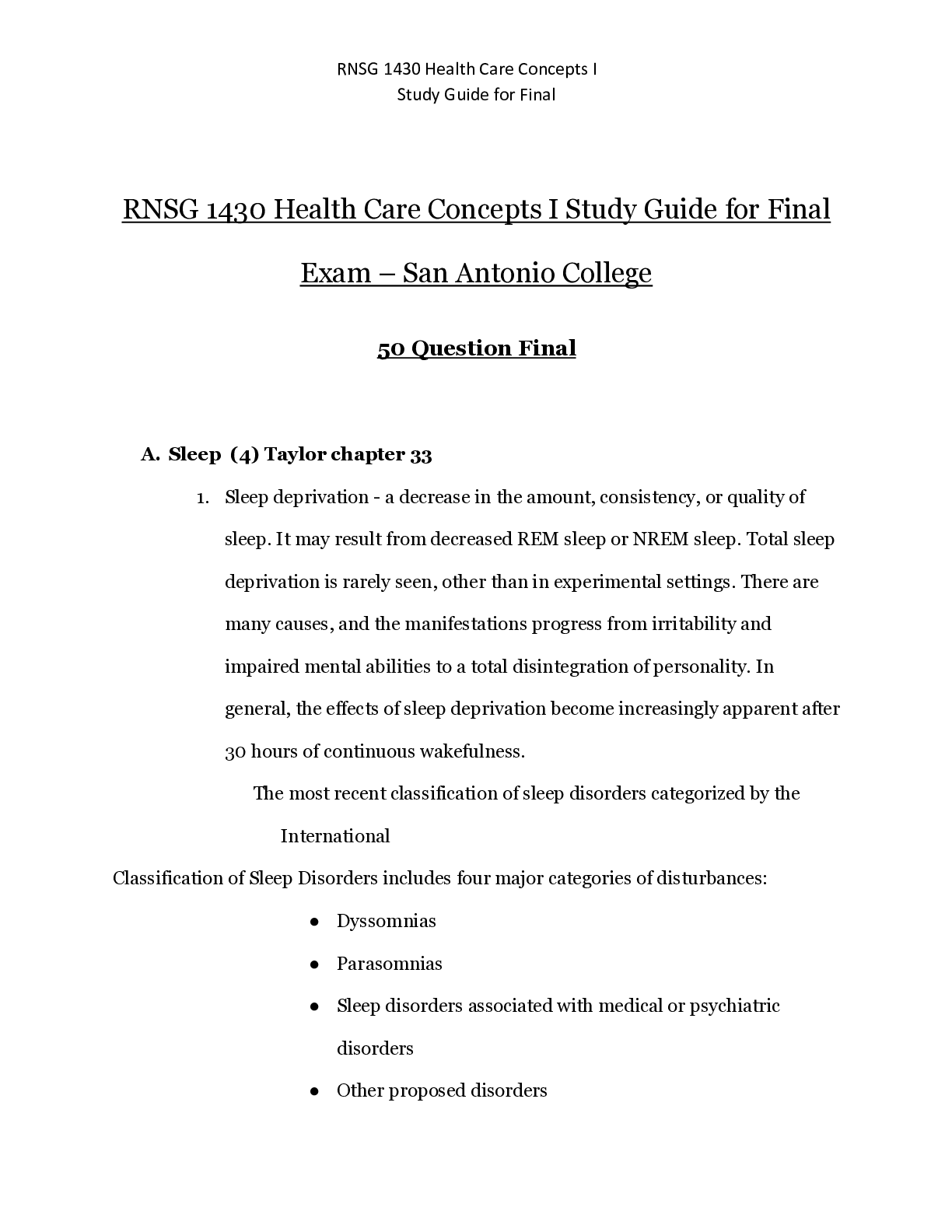
Buy this document to get the full access instantly
Instant Download Access after purchase
Add to cartInstant download
Reviews( 0 )
Document information
Connected school, study & course
About the document
Uploaded On
Nov 05, 2020
Number of pages
73
Written in
Additional information
This document has been written for:
Uploaded
Nov 05, 2020
Downloads
0
Views
125













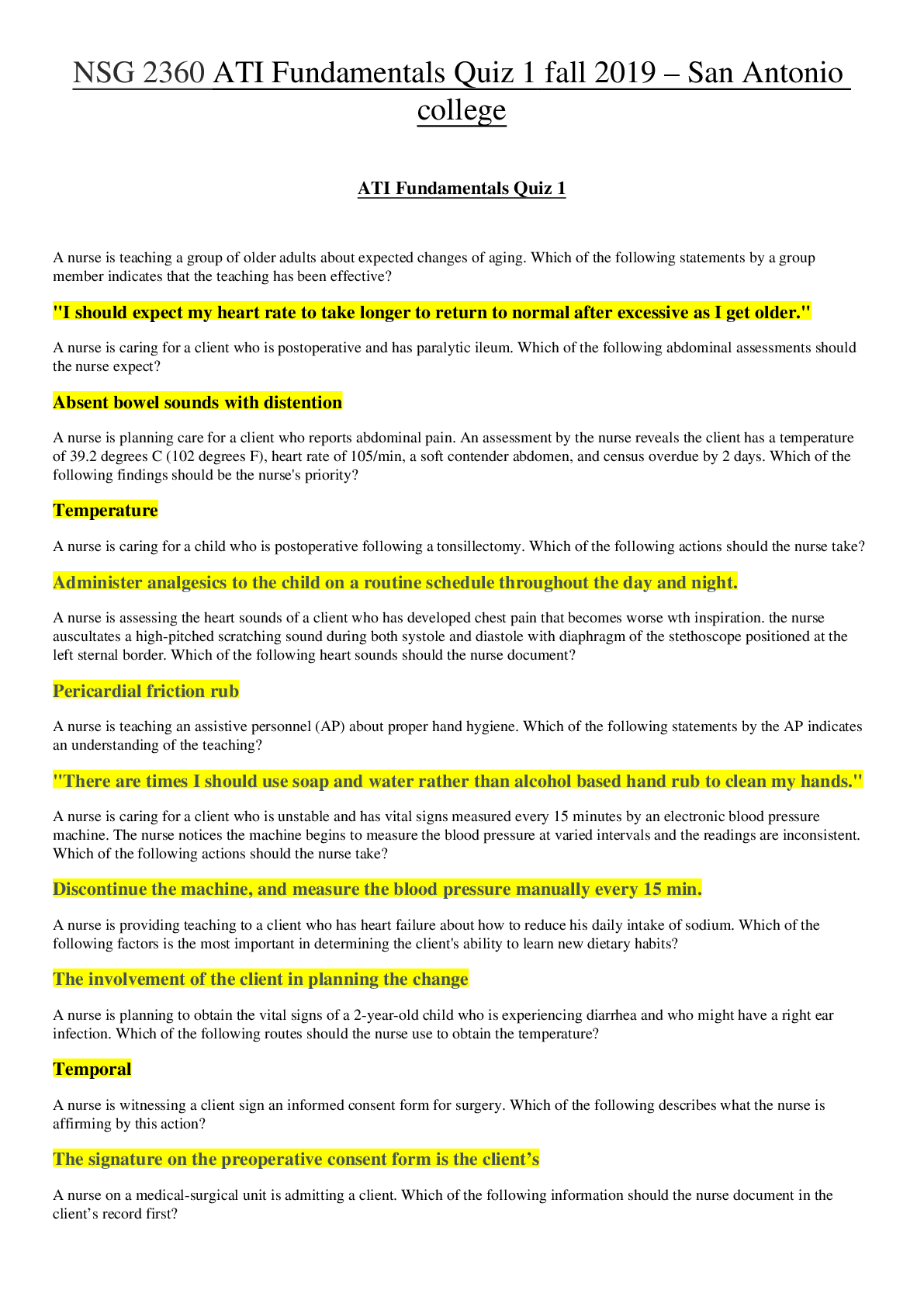

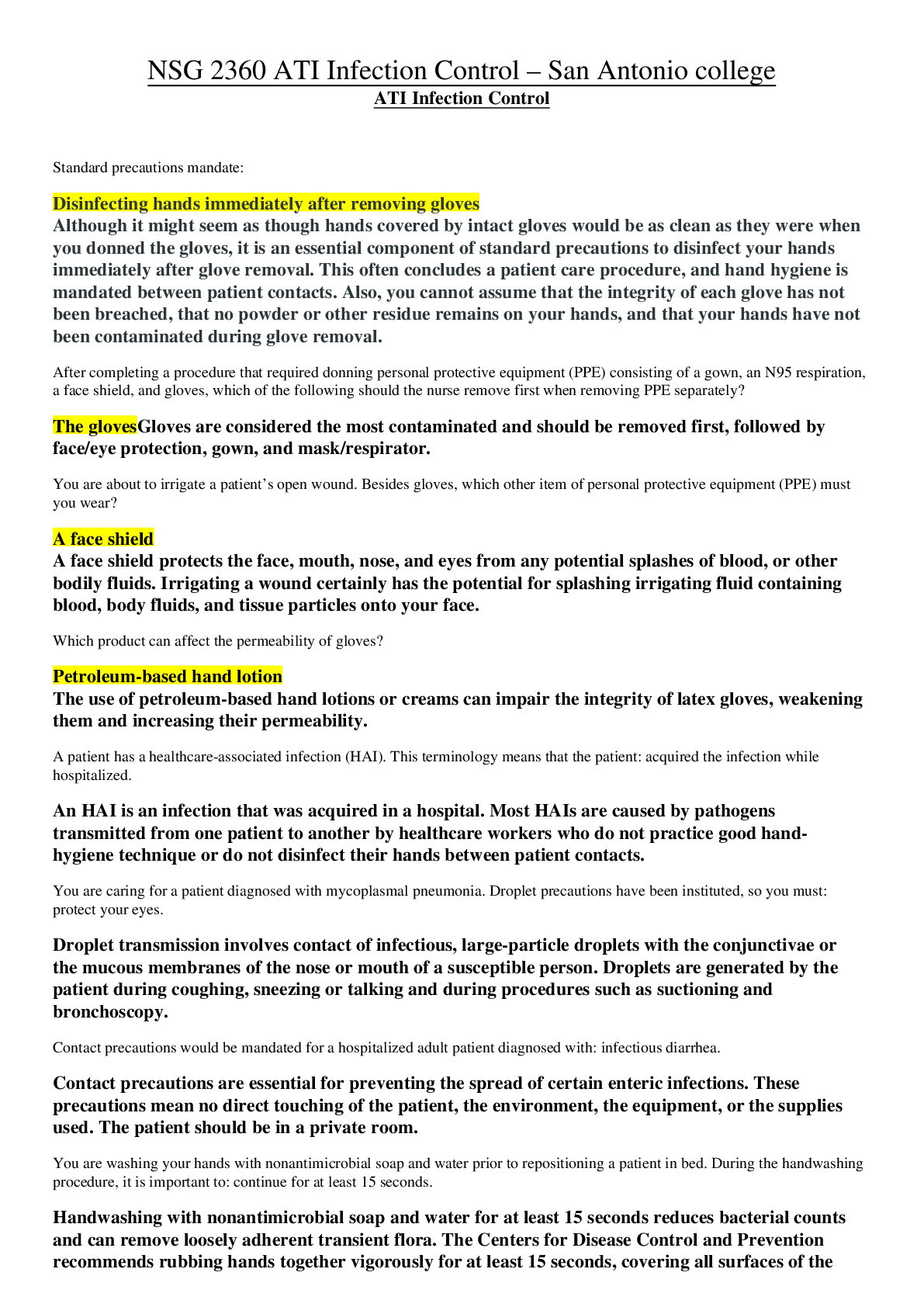
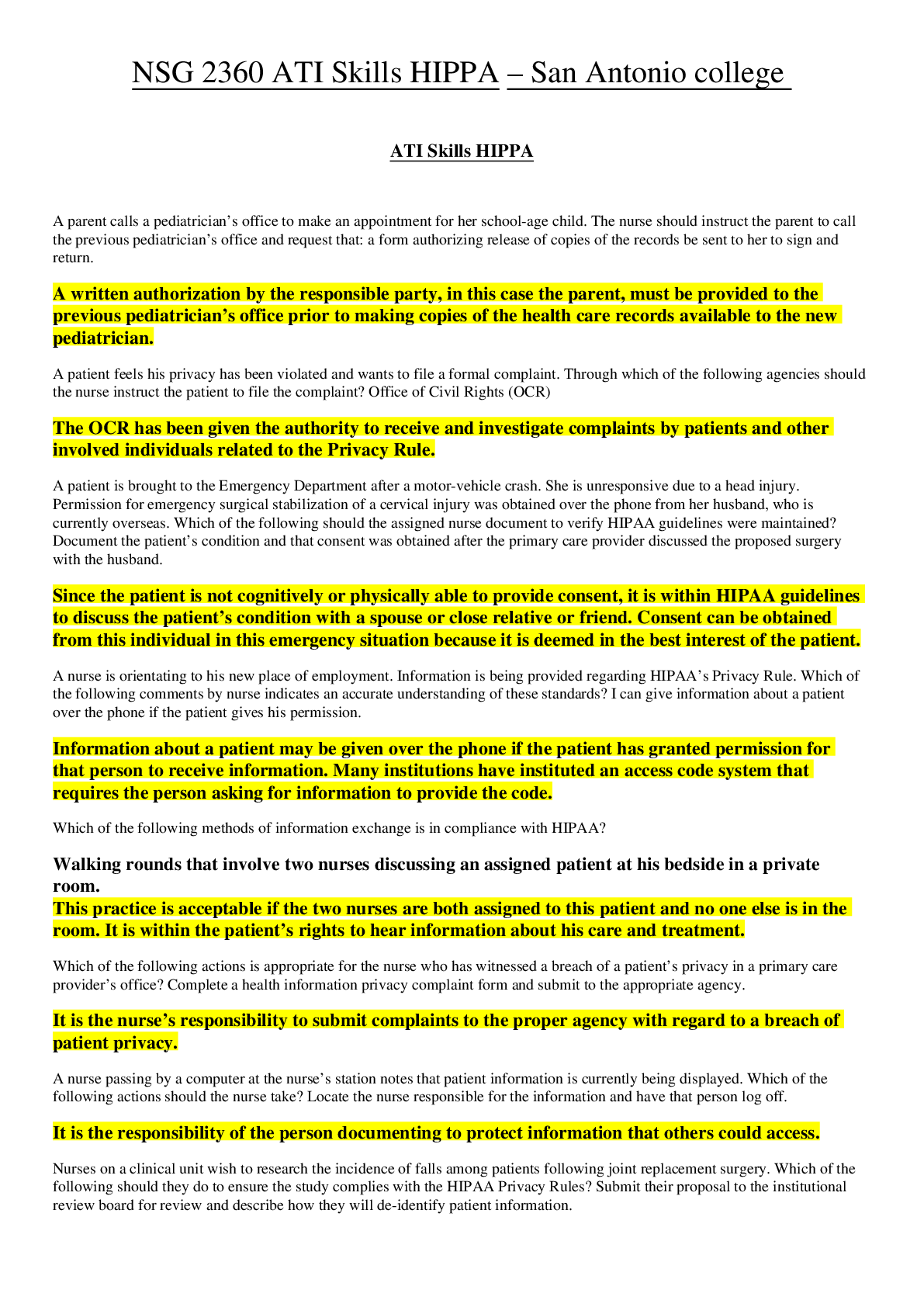
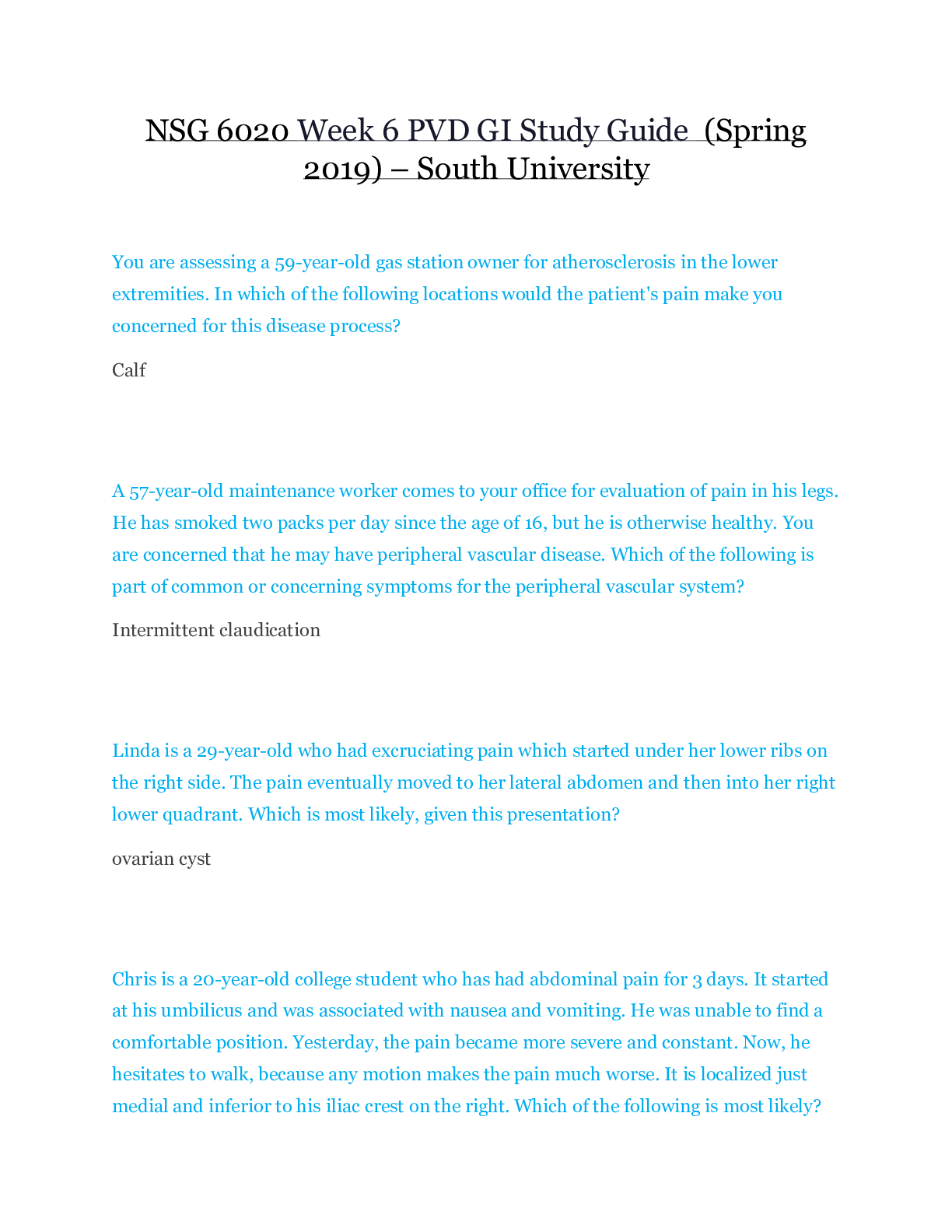
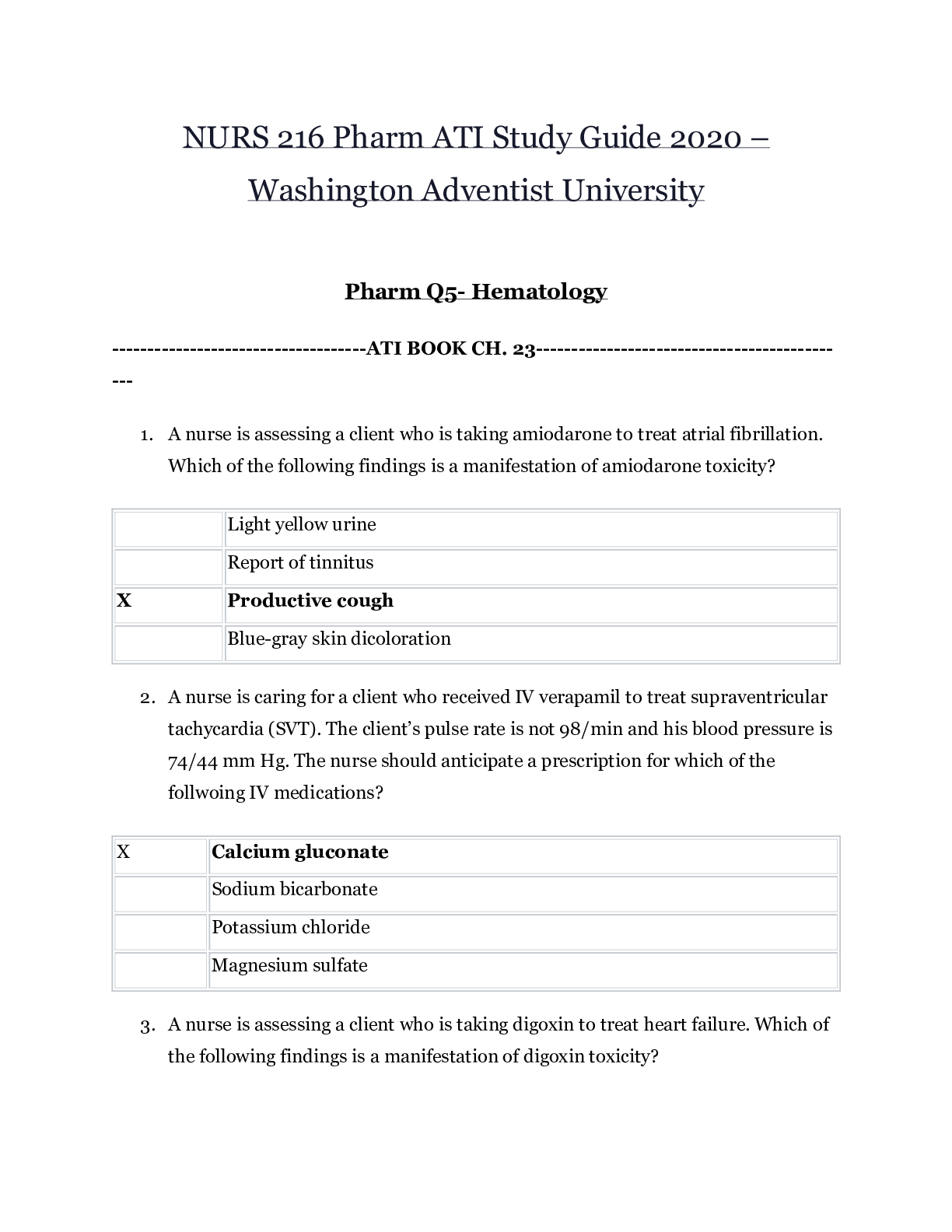
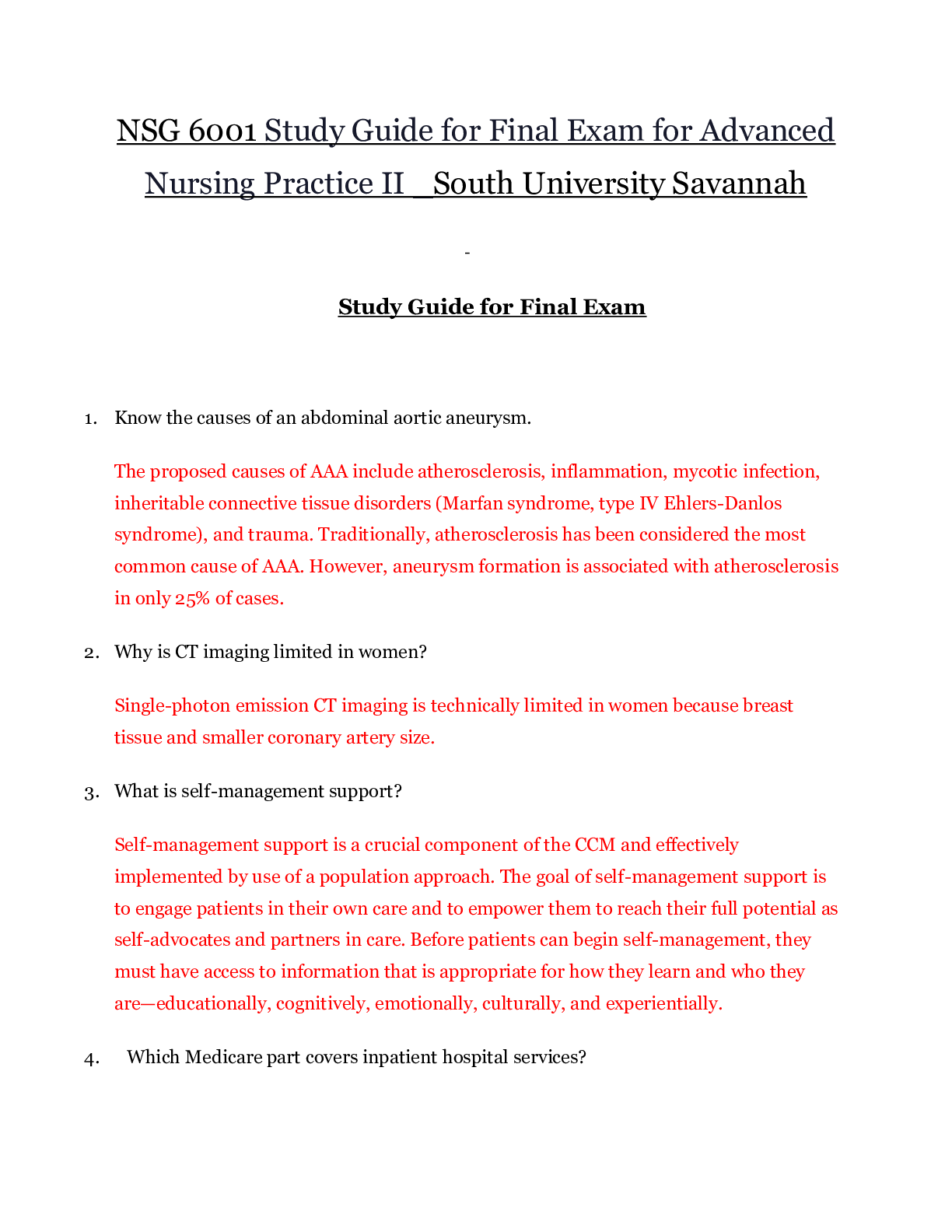
 – El Centro College.png)
